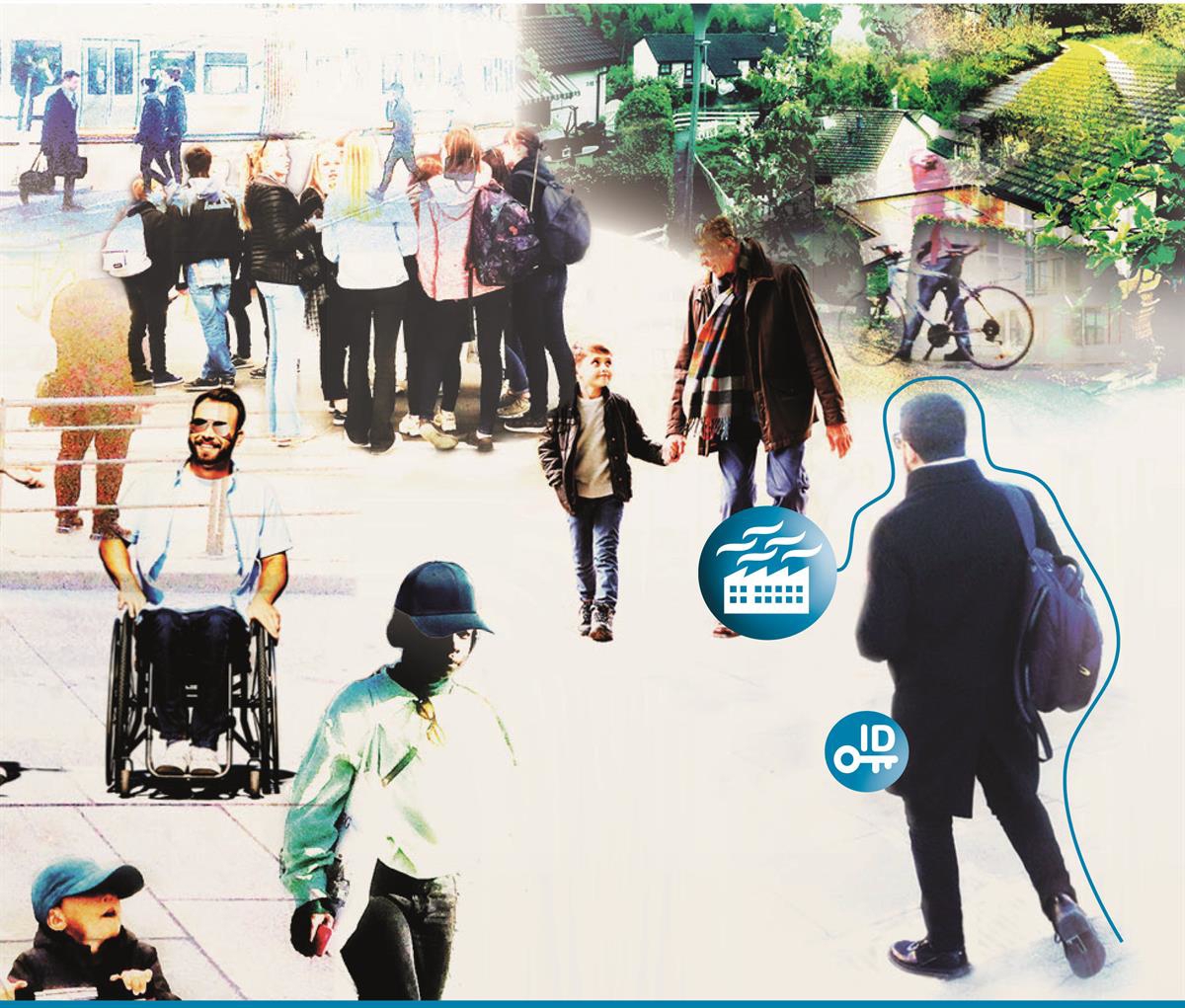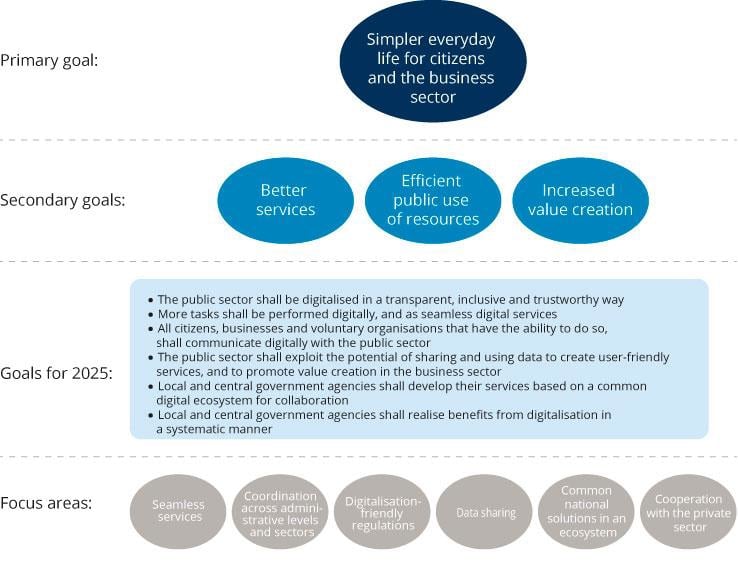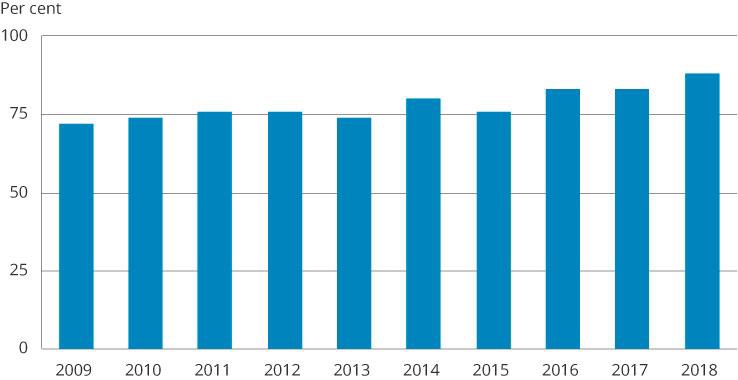1 Introduction

This strategy applies to the public sector for the period 2019–2025. The direction of the work on digitalising public services closely aligns with the guidelines in Report No. 27 (2015–2016) to the Storting Digital Agenda for Norway, and this strategy follows up the white paper. The strategy applies at the general level and provides guidelines for digitalisation activities in the public sector and any sector-specific strategies. The strategy is cross-sectoral, and should both maintain an overall perspective and support sectoral goals for digitalisation of the public sector.
Digitalisation of the public sector aims to give citizens, businesses and the voluntary sector a simpler everyday life through better services and more efficient use of resources by government agencies, and facilitate increased productivity in society at large. The purpose of the strategy is to support a digital transformation in the individual agencies and in the public sector as a whole. Digital transformation means changing the fundamental ways in which agencies perform tasks using technology. This means that the agencies will undergo radical changes aimed at achieving enhanced user experiences and smarter, more efficient performance of tasks. Such an approach may require the organisation to be restructured, areas of responsibility reorganised, regulations revised, or processes redesigned. This has as much to do with change management, skills and organisational development, public administration policy and public administration development as it does with technology.
The public sector needs to enhance its ability to work flexibly and innovatively so that new work methods and processes can be implemented. Digitalisation is not just about what we should digitalise, but how digitalisation can create innovation and improve efficiency. At the same time, a user-centric approach is not always compatible with improving efficiency in the public sector. This strategy shall facilitate smarter ways of performing tasks throughout the public sector and value creation in the business sector.
The strategy’s main measures focus on user-centric service development and more efficient and coordinated utilisation of common IT solutions by developing a common ecosystem for digital collaboration in the public sector. The strategy requires that cyber security be integrated into the service development, operation and management of common IT solutions, in accordance with the objectives of the National Cyber Security Strategy for Norway.
Goals for ourworktowards 2025:
- The publicsectorshall be digitalised in a transparent, inclusive and trustworthyway
- More tasksshall be performeddigitally, and as seamless services
- All citizens, businesses and voluntaryorganisationsthat have theability to do so, shallcommunicatedigitallywiththepublicsector
- The publicsectorshallexploitthepotentialofsharing and using data to createuser-friendly services, and to promotevaluecreation in the business sector
- Local and centralgovernmentagenciesshalldeveloptheir services basedon a common digital ecosystem for collaboration
- Local and centralgovernmentagenciesshallrealisebenefits from digitalisation in a systematic manner
To achieve these goals and support digital transformation, the strategy shall focus on the following areas:
- A user-centric focus through development of more seamless services based on key life events
- The public sector shall collaborate better on digital services and streamline the use of resources through enhanced coordination across administrative levels and sectors, and systematically realise benefits from digitalisation
- Data shall be shared and reused in the public sector to a greater degree, and open data shall be published for innovation and value creation in the business sector
- National digital collaboration and service development, common solutions and common architectures shall be established in a hierarchically controlled and coordinated ecosystem
- Cooperation with the private sector on digitalisation will be enhanced to achieve better, more efficient services and to facilitate innovation

Figur 1.1 Goals and focus areas in the digital strategy for the public sector for the period 2019–2025
Innovation in the public sector is the subject of a separate white paper due to be presented to the Storting (the Norwegian parliament) in 2020. A national strategy for artificial intelligence will launched in 2019. The Digital21 strategy was drafted by a government-appointed working group, and proposes initiatives for increased digitalisation in the business sector. These proposals will be followed up to some extent in this strategy. This applies in particular to the reuse of data, digitalisation- friendly regulations and public–private partnership.
Background
A narrower economic scope of action and increased expectations from users require that the public sector work in new ways. Coordination and cooperation across administrative levels and sectors is needed for the public sector to realise the benefits of new technology. We are well underway in digitalising the public sector. We have a good starting point with good basic data registers, a well-developed digital infrastructure and a high level of digital competence in the population.
Statistics Norway’s survey on the use of ICT in households shows that Norway ranks top in Europe in using public online services. In 2017, nine out of 10 people in Norway communicated with the public sector via the internet during the past year (see Figure 1.2 below). Few other countries in Europe have a corresponding use of public online services. In 2018, 88 per cent of Norwegians between the ages of 16 and 79 had used at least one of the three online services featured in the survey over the past twelve months. This represents an increase from 72 per cent in 2009 and from 83 per cent in 2017. The most common use of public online services is to search for information.1

Figur 1.2 Percentage of the population that has used public online services.
Statistics Norway
In its Digital Government Review of Norway from 20172 , the OECD cites Norway as one of the countries that has come furthest in digitalisation, but highlights the need for stronger governance and coordination of this work. The OECD particularly highlights the need for stronger coordination and clarification of roles and responsibilities between sectors and administrative levels. It recommends that Norway set ambitious and binding goals in the future to increase the pace of efficiency improvement and digitalisation. The Office of the Auditor General has also highlighted areas for improvement related to, for example, realising benefits, using common solutions and a need for stronger central governance.
Box 1.1 Governance and the distribution of responsibilities in public administration
The Government is the highest administrative body of the central administration, and is accountable to the Storting for preparing cases and implementing resolutions adopted by the Storting. The ministries shall ensure that adopted policies are implemented, often through external agencies such as directorates. The ministries are also responsible for managing and monitoring underlying agencies (agency governance) and state-owned companies (corporate governance).
The municipalities and county authorities are separate legal entities that can make decisions on their own initiative, and are responsible for, and exercise their autonomy within, a national framework, regulated in practice through statutes, regulations and budget limits adopted by the Storting. Local government autonomy is established by the Constitution and more closely regulated by the new Local Government Act adopted by the Storting on 22 June 2018. Limitations on local government autonomy must have statutory authority. The Local Government Act also establishes that local government autonomy should not be limited more than is necessary to safeguard national objectives
Safeguarding privacy protection and information security is critical to the success of the public sector in its digitalisation activities. Digitalisation requires far-reaching changes in the way the public sector performs its tasks, and thereby how documentation is protected and managed. The ambition to increase digitalisation in the public sector means that enhancing privacy protection and information security becomes increasingly important. Privacy protection and information security are fundamental to digitalisation activities and must constitute an integral component from the outset. Public confidence in the public sector is higher in Norway than in many other countries. Increased digitalisation shall protect citizens’ due process and privacy rights, and ensure a high level of confidence in the public sector. In January 2019, the Government presented a national strategy for cyber security and a national strategy for cyber security competence. Cyber security activities must be approached from an overall perspective, across sectors and administrative levels, and in the context of other civil protection activities.
Norway has close cooperation with the EU, Norway’s most important trading partner, in a number of important areas. This applies to, for example, the EU’s efforts to facilitate a digital internal market. The goal is to ensure that the business sector and private individuals can easily and efficiently interact digitally across national borders. The EU is preparing a new general IT strategy that will replace the current strategy after 2020. Norway is closely following this process and will contribute to formulating the new strategy. Norway will also cooperate closely with the EU on formulating new regulations and framework conditions for forward-looking technologies, including artificial intelligence and blockchain technology. In 2019, Norway signed declarations of cooperation with the EU on the digitisation of cultural heritage and on women and digitalisation.
Digital Europe Programme
The EU has proposed the establishment of a comprehensive digitalisation programme, Digital Europe Programme (DEP), for the period 2021–2027. It is the first time that the EU proposes a programme dedicated specifically to digitalisation, and the programme signals a change of pace in the initiative for the digital transformation of Europe. The programme has a proposed budget of EUR 9.2 billion divided into five main areas: High Performance Computing (EUR 2.7 billion), Artificial Intelligence (EUR 2.5 billion), Cyber security and Trust (EUR 2 billion), Digital Transformation and Interoperability (EUR 1.3 billion) and Digital Skills (EUR 0.7 billion). The Government is considering Norway’s possible affiliation with the DEP programme.
Digital North
In 2017, the Nordic Council of Ministers issued a declaration aimed at closer Nordic–Baltic cooperation on digitalisation. Closer cooperation shall enhance the digital transformation, but also increase the region’s potential to influence relevant processes in the EU. This cooperation shall also make it easier to develop cross-border digital infrastructures. From 2018, this cooperation was expanded by a ministerial declaration of cooperation on artificial intelligence and a declaration on the early adoption of 5G technology.